Birdfinding.info ⇒ Common in several parts of its range, especially across northern Venezuela, where it can often be found in and around Caracas, Lago de Valencia, and the western city Barquisimeto. In Colombia, the Santuario de Fauna y Flora Los Flamencos south of Riohacha is a consistent site. On Trinidad, it is common throughout the lowlands, including Port-of-Spain and the Caroni and Nariva Swamps. On Jamaica, it is most consistently found at arid sites such as Treasure Beach, Portland Ridge, and the Hellshire Hills, but also regular at Stewart Town, San San, and Ecclesdown Road.
Green-rumped Parrotlet
Forpus passerinus
Northern South America; introduced in the West Indies.
Locally common in various types of scrub and open woodland, from arid to humid, including savannas, mangroves, and agricultural areas.
Natural range extends from coastal northern Colombia and the Colombian Llanos east across Venezuela, and the Guianas to northeastern Pará, and upstream along the Amazon River to the Manaus area.
Introduced populations have been established on Jamaica and Trinidad since the early 1900s, and on Tobago since the 1950s. Formerly considered established on Barbados and Curaçao, but not reported from either island in recent years.
Identification
A typical Forpus parrotlet that strongly resembles several other members of its genus and to a lesser extent certain other parrotlets and small parakeets.
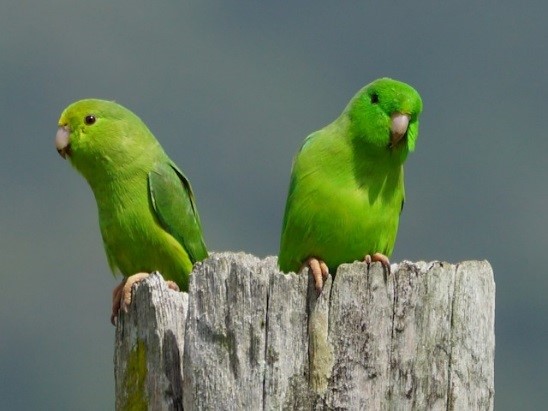
Green-rumped Parrotlet, female and male. (Aripo Livestock Station, Tunapuna-Piarco, Trinidad; April 5, 2015.) © Brian Ahern
Males are distinguished from similar species by the combination of mostly green plumage with blue in the wings—but not on the rump—and a pale bill. The precise distribution of blue on the wings is somewhat variable, both individually and among populations.
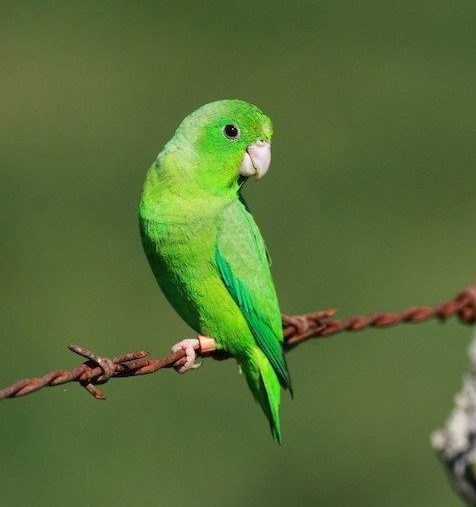
Green-rumped Parrotlet, male. (Hato Masaguaral, Guárico, Venezuela; September 22, 2010.) © Jay McGowan
At rest, with its wing folded tight, the male may appear all-green, but often exposes some turquoise on the wing. The green coloration is not uniform. Most noticeably, the male’s face is a more vivid shade of green.
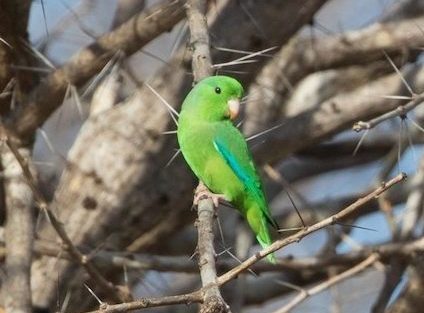
Green-rumped Parrotlet, male showing turquoise in the wing. (Cari-Cari, La Guajira, Colombia; February 25, 2018.) © Cory Gregory
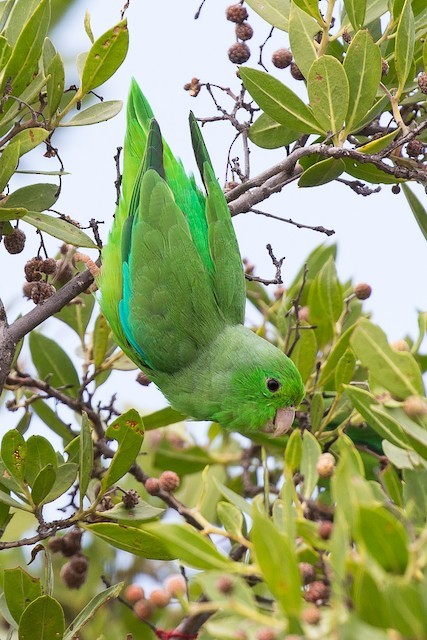
Green-rumped Parrotlet, male showing turquoise on the wing—also note the vivid green, slightly bluish color of the rump, which may cause confusion with Turquoise-winged. (Santuario de Fauna y Flora Los Flamencos, La Guajira, Colombia; February 13, 2017.) © Rob Felix

Green-rumped Parrotlet, male, evidently agitated. (Hato Masaguaral, Guárico, Venezuela; September 17, 2010.) © Jay McGowan
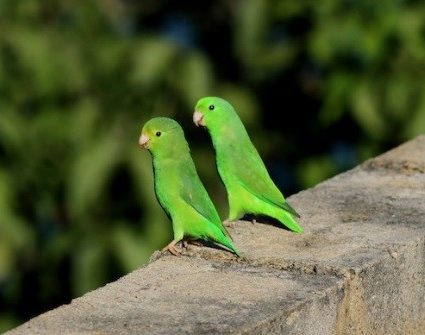
Green-rumped Parrotlet, female and male. (Las Salinas, Vargas, Venezuela; December 26, 2011.) © Jay McGowan
Females have essentially all-green plumage, including the wings, but typically show yellow in the face, especially on the forehead and around the eye. So similar to other female Forpus parrotlets that in areas where multiple species may occur, females are generally not identifiable without reference to accompanying males.

Green-rumped Parrotlet, female showing yellowish face, including the eyering. (Mondesir, Siparia, Trinidad; February 4, 2018.) © Tarran Maharaj
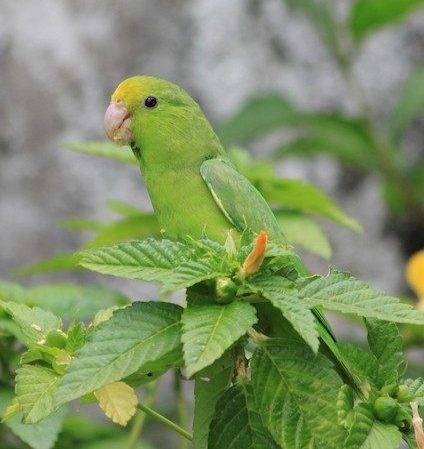
Green-rumped Parrotlet, female showing yellow forehead. (Cayenne, French Guiana; March 16, 2012.) © Nuno Gonçalves
In flight, the upperside of the male’s wing is mostly green with panels of turquoise and deep blue. The underwing has a dark blue stripe on the coverts.
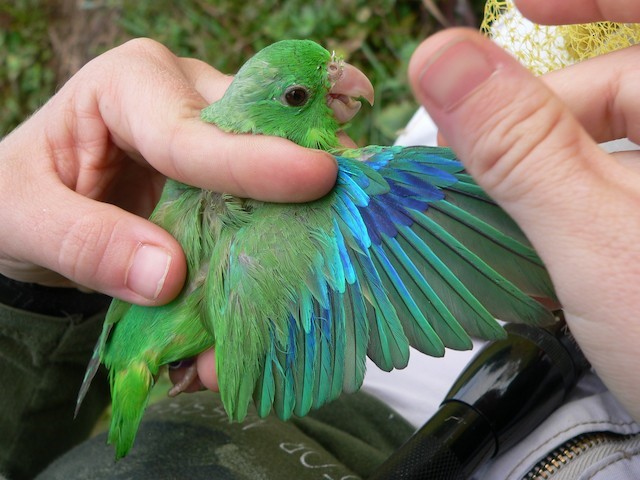
Green-rumped Parrotlet, male showing turquoise and deep blue stripes on wing coverts. (Hato Masaguaral, Guárico, Venezuela; September 18, 2008.) © Nicholas Sly

Green-rumped Parrotlet, male showing deep blue stripe on wing lining. (Caracas, Venezuela; June 1, 2018.) © Pedro Cabello-Maleno
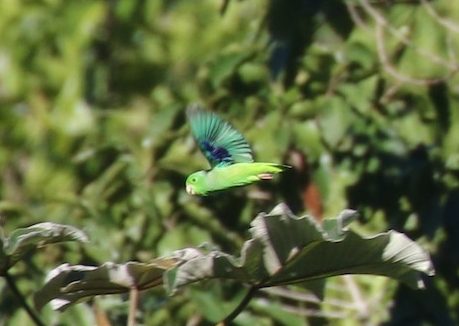
Green-rumped Parrotlet, male showing deep blue stripe on wing lining. (Stewart Town, Jamaica; February 2, 2019.) © Michael Woodruff
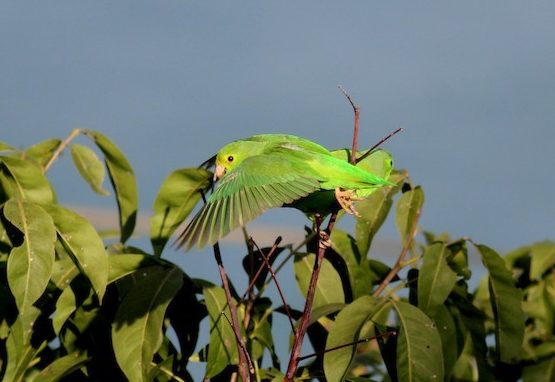
Green-rumped Parrotlet, female showing all-green upperwing, yellow eyering, and bright green rump. (Las Salinas, Vargas, Venezuela; December 25, 2011.) © Jay McGowan
Cf. Other Forpus Parrotlets. Males of similar Forpus species have blue rumps, and the females have all-green wings. The male Green-rumped is the only species with blue in the wing and a green rump. Range is also a strong clue, as Green-rumped has only limited overlap with similar species.
In northern Colombia, Turquoise-winged Parrotlet is nearly identical to Green-rumped—they may be conspecific—but the male has a pale turquoise rump. The females are probably indistinguishable.
Along the Amazon, particularly around Manaus, Blue-winged and Green-rumped overlap and are easily confused. The male Blue-winged has a darker blue rump and more extensive dark blue on the upperwings, but the females are probably indistinguishable.
In the Llanos along the Colombia-Venezuela border, overlap with Spectacled Parrotlet is possible. Male Spectacled has a dark blue rump and wing-patches, with pale blue spectacles. At rest, the female Spectacled resembles both sexes of Green-rumped, but has all-green wings and is deeper green than the female.
From eastern Venezuela to the lower Amazon, Green-rumped overlaps with Dusky-billed Parrotlet, which is identifiable in all plumages by the large dark patch on its upper mandible. Male Dusky-billed has a deep sapphire-blue rump and wing-patches. Both sexes are darker green than Green-rumped.
Notes
Polytypic species consisting of five recognized subspecies. Possibly conspecific with Turquoise-winged Parrotlet, which overlaps with Green-rumped in north-coastal Colombia.
References
Ascanio, D., G.A. Rodriguez, and R. Restall. 2017. Birds of Venezuela. Christopher Helm, London.
BirdLife International. 2018. Forpus passerinus. The IUCN Red List of Threatened Species 2018: e.T22685926A131918149. http://dx.doi.org/10.2305/IUCN.UK.2018-2.RLTS.T22685926A131918149.en. (Accessed May 5, 2019.)
Collar, N., and P. Boesman. 2017. Green-rumped Parrotlet (Forpus passerinus). In Handbook of the Birds of the World Alive (J. del Hoyo, A. Elliott, J. Sargatal, D.A. Christie, and E. de Juana, eds.). Lynx Edicions, Barcelona. https://www.hbw.com/node/54685. (Accessed December 1, 2017.)
ffrench, R. 2012. A Guide to the Birds of Trinidad & Tobago (Third Edition). Cornell University Press. Ithaca, N.Y.
Forshaw, J.M. 2010. Parrots of the World. Princeton University Press, Princeton, N.J.
Haynes-Sutton, A., A. Downer, R. Sutton, and Y.-J. Rey-Millet. 2009. A Photographic Guide to the Birds of Jamaica. Princeton University Press, Princeton, N.J.
McMullan, M., and T. Donegan. 2014, Field Guide to the Birds of Colombia (Second Edition). Fundación Proaves de Colombia, Bogotá.
Raffaele, H., J. Wiley, O. Garrido, A. Keith, and J. Raffaele. 1998. A Guide to the Birds of the West Indies. Princeton University Press, Princeton, N.J.
van Perlo, B. 2009. A Field Guide to the Birds of Brazil. Oxford University Press, Oxford.
Wells, J.V., and A.C. Wells. 2017. Birds of Aruba, Bonaire, and Curaçao. Cornell University Press, Ithaca, N.Y.
WikiAves, Tuim-santo, https://www.wikiaves.com/wiki/tuim-santo.

